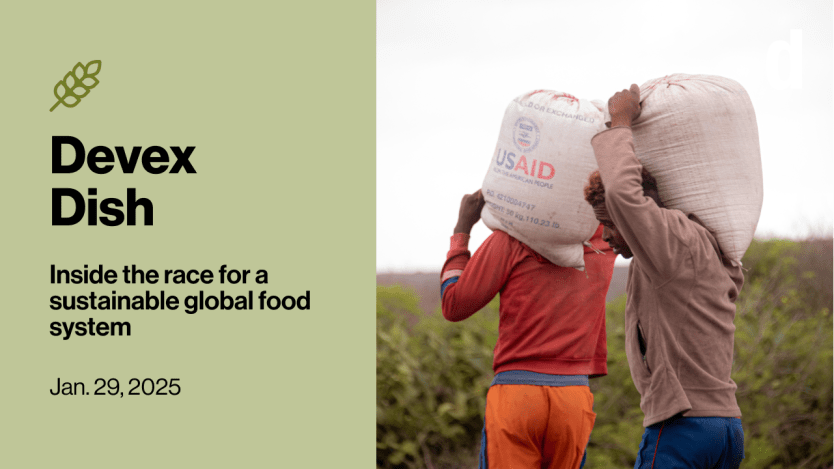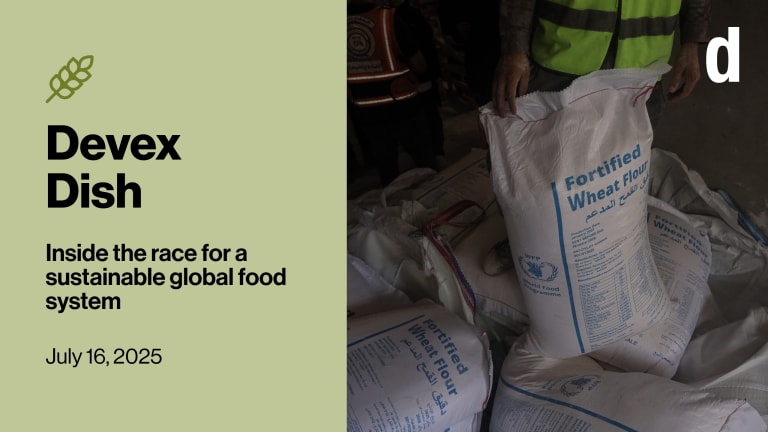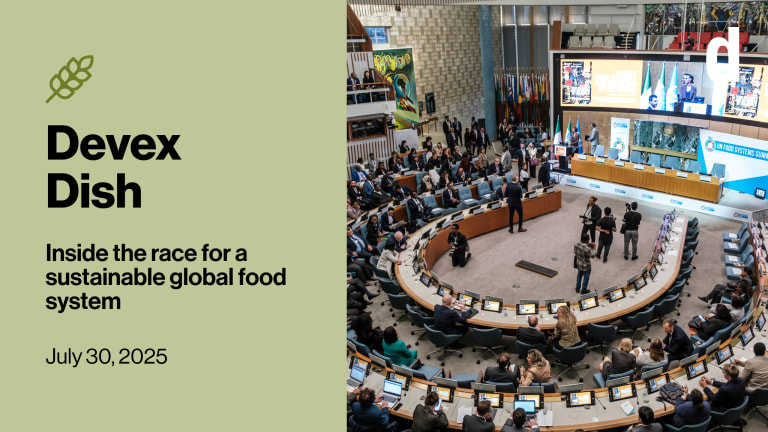
“Terrifying.” “Extremely concerned.” “Shock and disbelief.”
These are just some of the words I’ve heard in the past few days to describe the effects of U.S. President Donald Trump’s 90-day freeze on foreign aid, along with the stop-work order halting most of that work. In my 14 years as a journalist, I have rarely heard the level of fear and alarm that is gripping the food systems community right now.
As Dish readers know, the U.S. is the world’s biggest food aid donor. The U.S. Agency for International Development spends almost $5 billion on food aid annually. In addition to emergency aid, USAID’s flagship food security program is Feed the Future, which works to address root causes of hunger by boosting agriculture-led economic growth in 20 countries across Africa, Latin America, and Southeast Asia.
This freeze is all part of a Trump administration effort to ensure U.S. foreign aid is aligned with his “America First” agenda. And although the stop-work order exempts “emergency food assistance,” crucial work on food safety, nutrition, building resilience to climate shocks, and research to improve agricultural productivity has all been stopped. Feed the Future, given its longer-term focus, has ground to a halt.
Here’s what you need to know:
Define “emergency”: I went on a long journey — one might call it a rabbit hole — to learn what falls under the “emergency food assistance” exemption to the stop-work order. Do school meals count? Cash aid? Malnutrition treatment? It’s all ambiguous, but the answer may come down to where within the U.S. government’s budget a specific program’s funding comes from. (Shoutout to Stephanie Mercier, senior policy adviser at the Farm Journal Foundation, for helping me parse this). Two caveats: USAID did not get back to me by Dish’s send time to confirm, and four INGOs that deliver food aid that I spoke to are all interpreting this slightly differently.
Tick-tock: 90 days is a long time to stop food, nutrition, and agriculture programs. In a place like Sudan, where nearly 25 million people face acute hunger, food rations alone will do little to stop the spread of famine. “There are other life-saving core humanitarian assistance that are both complementary to food aid and just as important, like basic shelter,” nutrition, and WASH, a U.S.-based senior humanitarian official tells me. The freeze also coincides with the planting season for many crops in areas where the U.S. provides support, meaning a year’s worth of seeds and scientific research paid for by the American taxpayer may be lost — the irony is not lost on me. At least two INGOs that get more than one-third of their funding from the U.S. tell me they’ll have to drastically scale down operations amid immediate cash-flow issues triggered by their inability to access funds USAID has committed to them.
Slash-and-burn: USAID’s Bureau for Humanitarian Assistance, or BHA, has furloughed at least 500 contractors, or nearly 40% of its team, according to a scoop from my colleague Elissa Miolene. BHA works on crises such as in Sudan, Gaza, northern Syria, and Haiti, and a huge part of their work is delivering emergency food aid. “They’ve effectively just taken away the U.S.’ ability to respond to a humanitarian emergency,” one of those former officials tells Elissa. And you’re hearing this in Dish first: I’ve been told by one current and one former USAID official that furloughs have also hit the Bureau for Resilience, Environment, and Food Security, which runs Feed the Future. This follows a move Monday by USAID to put dozens of agency leaders on administrative leave.
Partner problems: USAID’s partners that deliver food and nutrition aid — whether they’re big INGOs, local organizations, or for-profit development contractors — are all trying to figure out which aspects of their work they can salvage. The World Food Programme appears to be shielded by the emergency food aid exemption, as my colleague Colum Lynch reports. Meanwhile, UNICEF, which delivers nutrition aid, said it remains “determined to deliver our support to children even as we work through the implications of the decision.” The U.S. contributes 45% of WFP’s $9.7 billion budget and 15% of UNICEF’s $8.9 billion budget. For humanitarian funding, the proportion of U.S. funding to the agencies is even higher.
Pause and effect: Everyone I spoke to questioned why work needs to stop as the U.S. State Department reviews foreign aid programs. “No one is disputing the value of a review or looking at the value proposition of foreign assistance,” the humanitarian official tells me. “But the pause … is causing real-world impacts now that will not be able to be undone, even if and when the pause is lifted.”
Uncertain future: Since Monday morning, the website for USAID’s Feed the Future has been “temporarily unavailable.” Links for some of the agency’s other food, nutrition, water, and climate programs are broken. Feed the Future innovation labs, which develop tech to feed a growing population amid climate change and are based at universities around the U.S., have been halted, two people tell me.
Bright spot? Late yesterday, Secretary of State Marco Rubio approved a new waiver for “life-saving humanitarian assistance” that would exempt some work from the 90-day pause, according to a memo, which my colleague Adva Saldinger obtained. Rubio defines it as “core life-saving medicine, medical services, food, shelter and subsistence assistance, as well as supplies and reasonable administrative costs as necessary to deliver such assistance.” It’s up to humanitarian groups to determine whether they qualify. To this we say … good luck to all.
Further reading: How Trump’s US aid stop-work order affects global food aid
Did we miss anything? Is your organization affected by the 90-day aid freeze? We’re collecting stories on what it means for the food systems community and would love to hear from you. Drop me a line at tania.karas@devex.com
Menu du jour
The orders, memos, and clarification from the State Department and USAID leadership are coming down almost as fast as we can report on them. Below is the best of Devex’s reporting:
Scoop: USAID furloughs hundreds of contractors from humanitarian bureau
USAID issues blanket stop-work order, promising ‘equitable adjustments’
Trump’s first 100 days: Tracking the impact on development work
USAID cancels stop-work Q&A with partners, citing stop-work order
Watch our Devex Pro briefing: ‘Game-changing moment’ in US foreign aid throws everything into doubt (Pro)
Senior USAID officials put on leave amid fallout from executive order
Trump’s executive order to withdraw from WHO, explained (Pro)
+ Not yet a Devex Pro member? Start your 15-day free trial today to access all our expert analyses, insider insights, funding data, and exclusive events, including another Pro briefing on the U.S. aid freeze on Feb. 3. Check out all the exclusive content available to you.
The case for agrifood investment
As the world keeps hiking up its military spending, one economist argues that investing ever-scarcer dollars in agrifood systems instead would bring around much more propitious conditions for peace.
In a Devex opinion piece, Máximo Torero Cullen, the Food and Agriculture Organization’s chief economist, is quick to highlight the economic implications of neglecting this “critical yet underappreciated pillar of global stability.” Agrifood systems provide livelihoods for 3.8 billion people worldwide and on the African continent, almost half of all workers rely on this sector for survival. The result of failing to invest in these systems include lost productivity, environmental degradation, increased health care burdens, and entrenched poverty.
Agrifood systems stand as a transformative lever for prosperity and long-term peace and resilience. The question is, how do we strategically invest in these systems to unlock their full potential, and in turn systemically address hunger and malnutrition?
Read the opinion piece: Investing in food systems is a safer bet than military spending
Eyes on the prize
Former U.S. Secretary of Agriculture Tom Vilsack has joined the World Food Prize Foundation as its CEO, a newly created position as the Des Moines, Iowa-based organization expands its events and programming beyond the United States. He takes up the role on March 1, and the foundation’s president, Mashal Husain, will report to him.
For Vilsack, it’s a homecoming: Prior to his two terms leading the United States’ agriculture department, he served two terms as Iowa’s governor. He has also worked with organizations that focus on agricultural trade and sustainable food production.
The foundation is behind the prestigious World Food Prize, known as the Nobel Prize for food and agriculture, as well as the annual Borlaug Dialogue, a three-day conference dedicated to exploring ideas to end hunger and food insecurity.
Background reading: World Food Prize president to step down as Mashal Husain takes over
And ICYMI: 150 Nobel and World Food Prize winners call for food security ‘moonshot’
Bringing home the bacon
Your next job?
Program Research Analyst, Sustainable Agriculture
World Resources Institute
India
Chew on this
What Trump’s pick to lead USDA, Brooke Rollins, thinks about food and nutrition. [Food Fix]
“Just bread and tea”: WFP says aid cuts to Afghanistan leave millions hungry this winter. [Reuters]
Algae could be the key to global food security. It’s also increasingly popular in Chile’s haute cuisine [DW]
With extreme heat making it perilous to work during the day, farm laborers from Brazil to India to the United States are starting to work overnight. But it comes with safety concerns and rights violations. [Grist]
Update, Jan. 31, 2025: This newsletter has been updated to reflect how the 90-day aid freeze may affect the World Food Programme.








